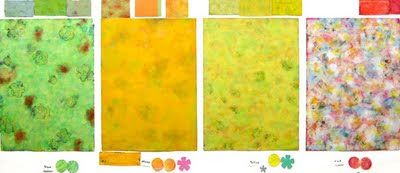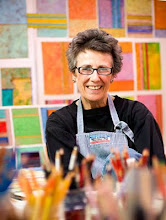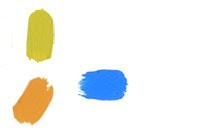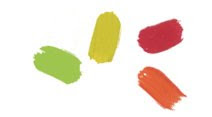The image above (Gift ©2000) is a past foray into building a quartet of single-color panels. It is small (8” x 6” each panel) and was assembled from my stock of painted paper. I chose the colors for their capacity to enhance each other. Far easier to do than the current project (see below), which is larger (35” x25” each) and the colors pre-ordained.
My usual approach when I paint is to barge ahead responding to what the painting seems to ask for. But with this new quartet, because I have destined each piece to be a specific color, and for the four panels to work together as a whole, I am forced to modify my operation. I have in mind a specific color for each and cannot let the work lead the way. Ordinarily the outcome I seek is more a quality or a “feel” and is not pre-determined. I rather think I have done my entire life that way, often horrifying and worrying some of my more pragmatic and probably wiser friends and family. I don’t mean to say that I have operated spontaneously, no, not my style. I have been slow and careful about choosing which fork in the road to follow. But my choices have been sort of romantic and impractical, and often with no real consideration of what the future might bring. The truth is that I haven’t always believed that one can count on having a future. Sacrificing today for a secure tomorrow never suited me. I have felt regret at times for some of those choices.
My style of painting has, however, always been impulsive. So much so that it has often happened that a work that started off well has been sent to Hell by a leap in the wrong direction. I have a sad memory of doing that when I was about nineteen years old. Some second year painting students were awarded a two week stay at the school’s camp in the mountains of northern New Jersey. It was my first experience of painting outdoors and I jumped right in with a landscape that was quickly done and full of my young energy. Even I knew it was special. A visiting artist of certain repute and our instructor both praised it. The next time my instructor saw the same landscape, a little further along, his comment was: “Oh my, what have you done?” What I had done was, in my neophyte innocence, thinking it couldn’t have any value as a painting because it was so hastily produced, I overworked it and eradicated its sparkle. That experience left its mark, obviously, as I still lament it all these many years later. And while spontaneity continues to be basic to my work, I have since been a bit more cautious. Which is not to say that I haven’t ruined many a promising beginning. Fortunately, acrylic paint is forgiving. While you can’t “revert to saved”, you can restart on the same canvas.
There is a story Elmer Bischoff told of the time when he shared a studio with Richard Diebenkorn and David Park. It seems that Park would often overwork his paintings and come up with a something his studio-mates called his “shit surface”. This description so angered Park that he would close himself in the small studio bathroom and emerge some time later with the same painting, reborn and shimmeringly beautiful. And that was before the advent of acrylic paint.
I started to say when I began this post that for the quartet pictured below, I am thinking through each step carefully before laying hand to brush. It was far easier the other way. It was play. Now it’s work.
Oscar Wilde: “Experience is the name everyone gives to their mistakes.”
The image below is the current state of the quartet in progress, 35” x 25” each, mixed media on heavy etching paper.















No comments:
Post a Comment